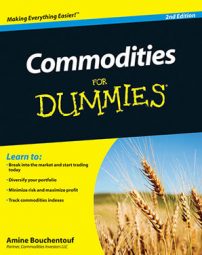Here’s some good news for commodities investors: A new wave of industrialization is taking place in the 21st century, and it may be the most important one in history. This wave is transforming a large number of developing countries into more industrialized countries, and raw materials are fueling this transformation.
The BRIC countries and commodities
Although many developing countries are on the fast track to industrialization, four countries need to be singled out as the frontrunners in this movement — Brazil, Russia, India, and China. They’re collectively known as the BRIC countries, or just the BRICs.
The BRIC countries, which are now on a path toward full industrialization, are scouring the globe to secure supplies of key natural resources such as oil, natural gas, copper, and aluminum — the raw materials necessary for a country to industrialize.
As demand from the BRIC countries for natural resources increases, expect to see increasing upward price pressures on commodities.
China and commodities
Although all four of the BRIC countries are rapidly transforming themselves, no other country is doing so as rapidly and dramatically as China. Fittingly, the saying “May you live in interesting times” is said to be an old Chinese proverb. The 21st century is undoubtedly going to be an interesting century, and China will play an increasingly important role in global economic affairs.
China’s GDP has increased by 9 percent each year from 2000 to 2006. To sustain this growth, China has been consuming all sorts of commodities. Some of the highs that commodities such as oil, natural gas, cement, copper, and aluminum have experienced between 2003 and 2006 are a direct result of increased demand from China.
In 2010, China surpassed Japan to become the world’s second-largest economy, behind only that of the United States. You can see the expected Chinese consumption of crude oil for the first quarter of the century.
![[Credit: Source: Energy Information Administration]](https://www.dummies.com/wp-content/uploads/320262.image0.jpg)
China is going to have a tremendous impact on the global economy in the 21st century and is expected to be the largest consumer of commodities in the world. For more information on China’s emergence as a global economic power and the transformation of the economic playing field that this entails, check out the following titles:
China, Inc.: How the Rise of the Next Superpower Challenges America and the World, by Ted Fishman (Scribner)
Three Billion New Capitalists: The Great Shift of Wealth and Power to the East, by Clyde Prestowitz (Basic Books)
The End of Poverty: Economic Possibilities for Our Time, by Jeffrey Sachs (Penguin)
Brazil and commodities
Another country that is having and will continue to have a significant impact on commodities markets worldwide is Brazil, the largest country in South America in terms of GDP, landmass, population, and abundance of natural resources.
Brazil’s geography, topography, and weather patterns make it a powerhouse in the commodities space. Consider a few of the natural resources in which Brazil is a world leader or has a dominant market share:
Coffee
Copper
Corn
Crude oil (offshore)
Eucalyptus
Gold
Iron ore
Livestock
Silver
Soybeans
Sugar
Sugarcane
Blessed with large amounts of arable land, the world’s largest river basin drainage systems (the Amazon), and favorable geology, Brazil is a world leader in commodities, especially agricultural commodities. Many companies are involved in the production and distribution of these natural resources, and as the world’s demand for these products increases, Brazil will likely do extremely well in the years and decades to come.

